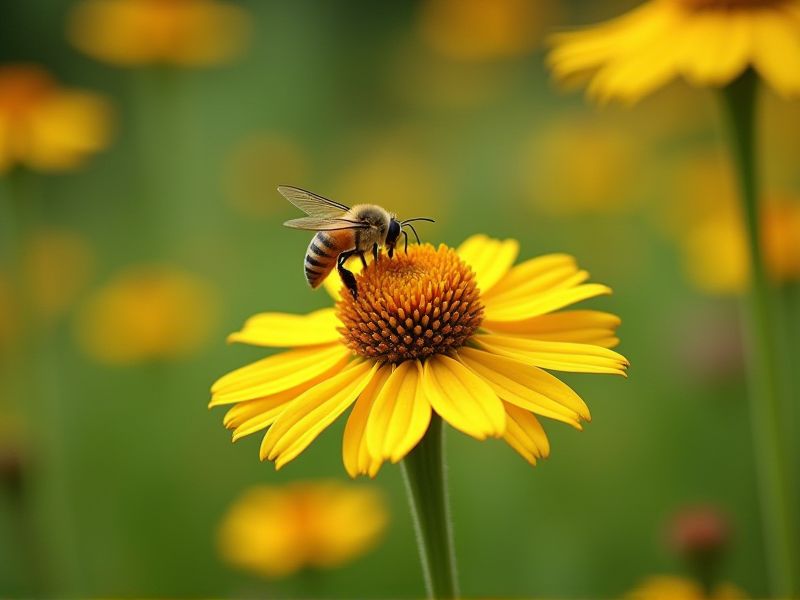
Low-maintenance pollinator-friendly plants include lavender, coneflower (Echinacea), and black-eyed Susan (Rudbeckia). These hardy perennials thrive in various soil types and attract essential pollinators like bees and butterflies to your garden. Planting sedum or catmint not only enhances your landscape but also provides a food source throughout the growing season. Incorporating these plants into your outdoor space can improve local biodiversity while requiring minimal care after establishment. Consider adding these vibrant species to create a beautiful and eco-friendly environment for your pollinator allies.
List of some Pollinator-friendly plants that are low-maintenance
- Lavender (Lavandula)
- Coneflower (Echinacea)
- Bee Balm (Monarda)
- Black-eyed Susan (Rudbeckia)
- Sedum (Sedum spp.)
- Salvia (Salvia spp.)
- Coreopsis (Coreopsis spp.)
- Yarrow (Achillea millefolium)
- Blanket Flower (Gaillardia)
- Catmint (Nepeta)
Important things about Pollinator-friendly plants that are low-maintenance
Native Species Support Local Pollinators.
Pollinator-friendly plants, such as Echinacea purpurea (purple coneflower) and Lavandula angustifolia (English lavender), provide essential nutrients to local pollinators like bees and butterflies while requiring minimal upkeep. These hardy species thrive in diverse soil conditions and often resist pests, allowing you to create a vibrant garden with little effort. By incorporating native flowering plants, such as Aster novae-angliae (New England aster) and Monarda fistulosa (wild bergamot), you can enhance biodiversity in your yard and support the health of your local ecosystem. Selecting low-maintenance pollinator-friendly plants fosters an environment where pollinators can flourish, contributing to a balanced natural habitat.
Drought-Tolerant Varieties Require Less Water.
Pollinator-friendly plants such as lavender, echinacea, and black-eyed Susan are low-maintenance options that thrive with minimal water. These drought-tolerant varieties not only provide essential nectar and pollen for bees, butterflies, and other pollinators but also enhance your garden's aesthetics. By selecting these resilient plants, you can create a vibrant landscape that supports biodiversity while conserving water resources. Incorporating such species ensures your garden remains both beautiful and sustainable.
Perennials Come Back Year After Year.
Pollinator-friendly perennials, such as coneflower and bee balm, not only support local ecosystems but also require minimal maintenance. These resilient plants attract essential pollinators like bees and butterflies, enhancing your garden's biodiversity. By selecting native varieties, you can ensure that these flowers thrive in your climate with little intervention. Incorporating these low-maintenance options into your landscape allows you to enjoy vibrant blooms while fostering a healthy environment for wildlife.
Minimal Pruning Needed For Many Options.
Selecting low-maintenance pollinator-friendly plants can enhance your garden's biodiversity with minimal effort. Species like lavender, coneflower, and bee balm not only attract essential pollinators such as bees and butterflies but also require little pruning. Native plants, including milkweed and asters, thrive in various soil conditions, promoting resilience and sustainability in your outdoor space. By incorporating these options, you can create a vibrant, low-care ecosystem that supports vital pollinator populations.
Long Blooming Seasons Attract Diverse Pollinators.
Pollinator-friendly plants such as lavender, echinacea, and butterfly bush are excellent low-maintenance choices for your garden, offering vibrant blooms and essential nectar. These plants thrive in various soil types and require minimal care, making them ideal for busy gardeners. By incorporating them into your landscape, you not only enhance the aesthetic appeal but also support local bee, butterfly, and hummingbird populations. Opting for native species further ensures that you create a sustainable environment that fosters biodiversity and encourages a thriving ecosystem.
Low Fertilizer Needs Reduce Maintenance.
Pollinator-friendly plants such as lavender, sedum, and echinacea are excellent choices for gardens that require minimal upkeep while promoting biodiversity. These species thrive in well-drained soils and can flourish without excessive fertilization, making them ideal for low-maintenance landscapes. By incorporating these hardy plants, you can attract essential pollinators like bees and butterflies, enhancing your garden's ecological balance. You can enjoy flourishing blooms and vibrant wildlife with less time spent on maintenance and more on appreciating nature.
Attract Beneficial Insects, Improving Garden Health.
Pollinator-friendly plants such as lavender, coneflower, and aster are excellent low-maintenance options for enhancing your garden's health. These plants not only provide nectar and pollen for bees, butterflies, and other beneficial insects but also require minimal care, thriving in various soil types and conditions. Incorporating these species into your landscape can create a vibrant ecosystem that supports pollinators while ensuring effortless upkeep. By selecting these hardy plants, you will promote biodiversity and improve the overall resilience of your garden environment.
Grouping Plants Enhances Pollinator Accessibility.
Pollinator-friendly plants, such as lavender, salvia, and coneflower, attract a variety of beneficial insects while requiring minimal care. These hardy species thrive in diverse soil conditions and offer vibrant blooms that provide nectar and pollen throughout the growing season. By planting these low-maintenance options in clusters or groupings, you can create an inviting habitat that draws in bees, butterflies, and other pollinators. Choosing native varieties also supports local ecosystems, ensuring your garden benefits both pollinators and the environment.
Diseases And Pests Are Less Prevalent In Resilient Varieties.
Pollinator-friendly plants such as lavender, coneflower, and salvia are excellent choices for gardeners seeking low-maintenance options. These resilient varieties not only attract essential pollinators like bees and butterflies but also display a high resistance to common diseases and pests. By incorporating these plants into your landscape, you can create a thriving ecosystem while minimizing the need for chemical treatments. Embracing these durable options ensures a vibrant garden that supports biodiversity and is easy to care for.
Diverse Colors And Shapes Support Various Pollinator Preferences.
Pollinator-friendly plants such as lavender, coneflower, and catmint thrive with minimal care while attracting bees, butterflies, and other vital pollinators. These hardy perennials flourish in well-drained soil and require little watering once established, making them perfect for busy gardeners. Choosing native species, like purple prairie clover or black-eyed Susan, enhances local ecosystems and encourages native pollinator populations. By selecting these low-maintenance options, you can create a vibrant garden that sustains pollinators and adds beauty to your landscape.
